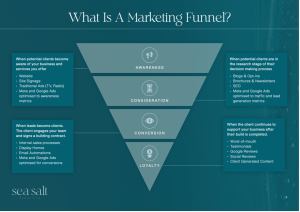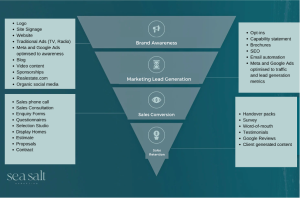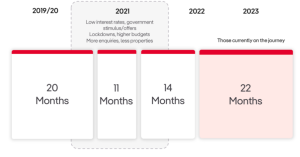Understanding the difference between marketing-qualified and sales-qualified leads is essential to the success of any business. While their roles are complementary, sales and marketing are not the same thing.
In this blog, we’ll delve into:
- The specifics of the marketing and sales funnels
- The relationship between marketing-qualified and sales-qualified leads
- How to turn marketing-qualified leads into sales-qualified leads
- Our top tips for generating, nurturing and converting leads
Continue reading to learn more.
What Is The Marketing Funnel?
Before we can understand the difference between marketing and sales leads, we need a clear understanding of the marketing funnel. This is essentially a model of the customer journey that guides clients from awareness towards conversion. The marketing funnel has four stages – brand awareness, consideration, conversion and loyalty.
As we can see in the model below, the primary function of marketing is to make potential clients aware of a business and their services through various marketing activities. As clients progress through the consideration and conversion stages, they become marketing leads.

Creating marketing leads is not a matter of simply tossing potential clients into the funnel and waiting for them to come out the bottom; a tailored marketing strategy is required to encourage them along the journey.
This might include Meta ad campaigns optimised for traffic and awareness, informative blogs that educate and establish authority, and targeted email campaigns that guide prospects towards conversion during the consideration phase.
Once a potential client reaches the conversion stage and become a marketing-qualified lead, they are then passed on to the sales team who will qualify them and nurture them into a client.
In many building businesses the sales team may be the owner of the business, so having a really clear, strong sales process to feed your marketing leads into will help to maximise the ROI on your marketing spend.
What is The Sales Funnel?
Once a lead is handed over to the sales team, it enters the sales funnel. Much like the marketing funnel, the sales funnel is a model of the customer journey through the sales process. The first step is for the sales team to qualify the lead. Once the lead is sales-qualified, the potential client has been deemed a good fit for the business and is ready for the next stage in the journey.
While the marketing funnel is focused on building brand awareness, establishing authority and engagement, the sales funnel is responsible for nurturing the lead through to sales conversion and managing the process afterwards. The role of sales might include discovery calls and consultations, display home and style studio walk throughs and managing proposals and contract documentation.
The Relationship Between the Sales and Marketing Funnels
While the marketing and sales funnels each play their own distinct roles, they share a single goal – converting prospects into clients. Rather than thinking of them as separate funnels, it can be helpful to look at these models as one sales and marketing funnel that covers brand awareness, marketing lead generation, sales conversion and sales retention.

Consider this example – let’s say a builder in Melbourne’s bayside wants to target professionals looking to build a new custom home. They might engage a marketing agency to establish a multi-faceted marketing strategy that includes the following elements:
- Branded site signage
- Tailored Meta and Google Ads campaign, designed to target 35–60 year olds living in Melbourne’s bayside that are interested in building
- Educational opt-in targeting the pain points of the builder’s ideal client
- Automated email series that educates and inspires, keeping the builder front of mind
This tailored strategy builds brand awareness in the local area and will generate marketing leads that are early in their decision-making process. Thanks to the intricate customisation options available, and the careful research of the marketing team, these leads will be considered marketing qualified. These leads can then be fed into a CRM system where the sales team will undertake their own qualification process and set to work on sales conversion.
Once the lead has been converted and a building contract signed, the sales and construction team will nurture the client through the building journey and into the retention stage, where they might provide a testimonial, offer a referral, or engage the builder again. The sales retention stage is similar to the ‘loyalty’ stage of the traditional marketing funnel.
Through this example, we can see just how important it is to understand your ideal client before engaging a marketing agency to create a campaign. The more information you have about your ideal client, the more tailored your marketing campaigns will be and the more likely you are to attract quality leads.
How to Turn Marketing Leads into Sales Leads
One of the biggest challenges many builders face is turning marketing leads into sales leads. Firstly, it’s important to understand your contact to contract timeframe – how long is the time between a client first engaging with you (this could be downloading your opt-in) and then signing a building contract with you.
According to recent research from realestate.com.au this process has doubled over the last 2 years for a new home builder and is now sitting at around 22 months.

Source: Realestate.com.au developer insights VIC 2023
Given this, we can see the importance of continued investment in marketing that focusses on all stages of the funnel and on multiple channels to encourage prospects to convert.
While patience is important throughout the decision-making process, there are a number of ways you can help to nurture clients from marketing lead to sales conversion. This includes investing in a CRM, utilising automation and hiring a business or sales coach.
Invest in a CRM
Utilising a customer relationship management (CRM) platform can take much of the stress out of managing your sales process. Through this platform, you can organise contacts, prioritise leads and track your sales pipeline so you can see where various leads are in your sales funnel.
Utilise automation
Automating your sales process is a great way to guide the decision-making process and streamline your workload. For example, you could have an automation triggered when a marketing lead enters the CRM the sales team receive an automatic notification and can contact the prospect immediately. This is a very useful tool, as the longer a potential client waits around, the more likely they are to drop out of your funnel altogether.
Automated email series are also helpful throughout this process, as you can set the timing based on common patterns to ensure potential clients are being targeted at the right time in the journey. An email sent at the right moment, featuring a handy building or design tip or a blog that addresses a common pain point, could be exactly the thing to tip a prospect over to the next stage of the marketing and sales funnel.
You can also see what content your clients a clicking on, so when you do make the sales call you’re armed with loads of information on what your clients are interested in and you can tailor your conversations towards solutions around that.
Hire a sales or business coach
Many builders don’t come from a business or sales background – they’ve worked their way up from the tools. And while this is an advantage, as it means you have a first-hand perspective on the building process and a unique insight into all facets of construction, it can make setting up an effective sales process challenging.
For builders in this position, we highly recommend engaging a coach to help you put the right strategies in place. A sales or business coach who specialises in the construction industry can educate you on the sales process and have you converting marketing-qualified leads into signed building contracts in no time.
Top tips for generating, nurturing and converting leads
Both the construction industry and Australia’s economic landscape have changed drastically over the last two years, so it makes sense that what worked a few years ago won’t necessary work today.
Here are our top tips for generating, nurturing and converting leads:
- Adopt a multi-channel approach to marketing
According to Hubspot, a client needs up to 8 touchpoints before they become a lead. An effective marketing strategy requires a multi-faceted approach – you want to target your ideal client from all angles. This might include a combination of traditional and digital media platforms or be more focused on digital marketing, depending on your company and your target audience.
2. Up your marketing spend
As the saying goes, you need to spend money to make money, and this certainly applies to digital marketing. With the industry becoming more competitive every day, it costs more to see results on your marketing efforts than ever before – once you have a clear strategy that works, investing more is one of the best ways to achieve marketing success.
3. Invest in fresh content
Investing in fresh content, including imagery, videos, opt-ins and blogs is essential to attracting new clients and engaging old ones. As our attention spans get shorter, potential clients get tired of seeing the same thing repeatedly. Refreshing your content every 6 months at a minimum is the target in this current climate.
4. Understand your ideal client
If you’re finding that the leads you’re generating aren’t being easily guided towards conversion, it may be time to review your target audience. Take some time to consider your ideal client and the qualities they share. Use this information to inform your marketing activities and you may just be surprised at the results.
___
The start of the year is a great time to review your marketing strategy and sales process to ensure they are aligned and working effectively.
If you’re looking for an experienced marketing company to create an effective marketing strategy for your construction business, get in touch with Sea Salt Marketing. We can also put you in touch with specialist sales and building coaches who can help to revolutionise your sales process.
